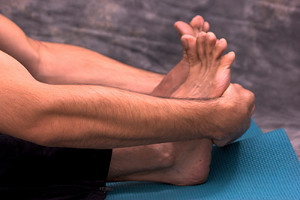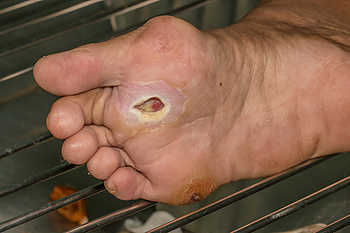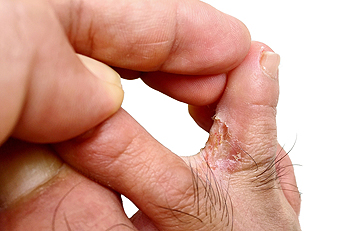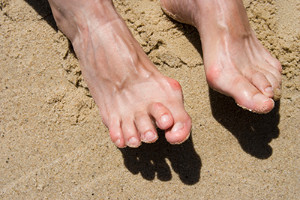Items filtered by date: January 2020
Foot Stretches for Runners
 In order to help strengthen your feet and prevent getting an injury, it’s recommended that you incorporate foot stretches in your daily routine. Performing these light exercises during your warmup before a run may help keep your feet flexible, and better prepare them for the activity. One type of exercise you can practice is the big toe extension lunge. To perform this, start by standing inside a door frame and leaning your big toe against the wall angled upward. You will begin to feel a stretch in your big toe once you begin to lunge forward. Another type of foot stretch you can practice is done by rolling either a lacrosse ball or massage ball back and forth under the arch of your foot. This kind of stretch is particularly useful after a run, as it helps to relax the muscles underneath your foot. For more tips on stretching your feet, we recommend you speak with a podiatrist for professional advice.
In order to help strengthen your feet and prevent getting an injury, it’s recommended that you incorporate foot stretches in your daily routine. Performing these light exercises during your warmup before a run may help keep your feet flexible, and better prepare them for the activity. One type of exercise you can practice is the big toe extension lunge. To perform this, start by standing inside a door frame and leaning your big toe against the wall angled upward. You will begin to feel a stretch in your big toe once you begin to lunge forward. Another type of foot stretch you can practice is done by rolling either a lacrosse ball or massage ball back and forth under the arch of your foot. This kind of stretch is particularly useful after a run, as it helps to relax the muscles underneath your foot. For more tips on stretching your feet, we recommend you speak with a podiatrist for professional advice.
Stretching the feet is a great way to prevent injuries. If you have any concerns with your feet consult with one of our podiatrists from Sayville Foot Care. Our doctors will assess your condition and provide you with quality foot and ankle treatment.
Stretching the Feet
Stretching the muscles in the foot is an important part in any physical activity. Feet that are tight can lead to less flexibility and make you more prone to injury. One of the most common forms of foot pain, plantar fasciitis, can be stretched out to help ease the pain. Stretching can not only ease pain from plantar fasciitis but also prevent it as well. However, it is important to see a podiatrist first if stretching is right for you. Podiatrists can also recommend other ways to stretch your feet. Once you know whether stretching is right for you, here are some excellent stretches you can do.
- Using a foam roller or any cylindrical object (a water bottle or soda can will do), roll the object under your foot back and forth. You should also exert pressure on the object. Be sure to do this to both feet for a minute. Do this exercise three times each.
- Similar to the previous one, take a ball, such as a tennis ball, and roll it under your foot while seated and exert pressure on it.
- Grab a resistance band or towel and take a seat. If you are using a towel, fold it length wise. Next put either one between the ball of your foot and heel and pull with both hands on each side towards you. Hold this for 15 seconds and then switch feet. Do this three times for each foot.
- Finally hold your big toe while crossing one leg over the other. Pull the toe towards you and hold for 15 seconds. Once again do this three times per foot.
It is best to go easy when first stretching your foot and work your way up. If your foot starts hurting, stop exercising and ice and rest the foot. It is advised to then see a podiatrist for help.
If you have any questions, please feel free to contact our office located in Sayville, NY . We offer the newest diagnostic and treatment technologies for all your foot care needs.
Wounds on the Feet May Be a Serious Condition
 A wound is considered to be a laceration. Patients who are dietetic may be familiar with the possibility of getting wounds on the feet. If these are not promptly treated, an infection may develop, and can potentially be a serious condition. Wounds on the feet may be less serious for people who are not diabetic, and minor wounds may be treated with surgical tape. Research has indicated the importance of keeping the wound and surrounding area dry and clean, as this may help to prevent an infection. If you have any type of wounds on the feet, it is strongly suggested that you consult with a podiatrist who can properly treat this condition.
A wound is considered to be a laceration. Patients who are dietetic may be familiar with the possibility of getting wounds on the feet. If these are not promptly treated, an infection may develop, and can potentially be a serious condition. Wounds on the feet may be less serious for people who are not diabetic, and minor wounds may be treated with surgical tape. Research has indicated the importance of keeping the wound and surrounding area dry and clean, as this may help to prevent an infection. If you have any type of wounds on the feet, it is strongly suggested that you consult with a podiatrist who can properly treat this condition.
Wound care is an important part in dealing with diabetes. If you have diabetes and a foot wound or would like more information about wound care for diabetics, consult with one of our podiatrists from Sayville Foot Care. Our doctors will assess your condition and provide you with quality foot and ankle treatment.
What Is Wound Care?
Wound care is the practice of taking proper care of a wound. This can range from the smallest to the largest of wounds. While everyone can benefit from proper wound care, it is much more important for diabetics. Diabetics often suffer from poor blood circulation which causes wounds to heal much slower than they would in a non-diabetic.
What Is the Importance of Wound Care?
While it may not seem apparent with small ulcers on the foot, for diabetics, any size ulcer can become infected. Diabetics often also suffer from neuropathy, or nerve loss. This means they might not even feel when they have an ulcer on their foot. If the wound becomes severely infected, amputation may be necessary. Therefore, it is of the upmost importance to properly care for any and all foot wounds.
How to Care for Wounds
The best way to care for foot wounds is to prevent them. For diabetics, this means daily inspections of the feet for any signs of abnormalities or ulcers. It is also recommended to see a podiatrist several times a year for a foot inspection. If you do have an ulcer, run the wound under water to clear dirt from the wound; then apply antibiotic ointment to the wound and cover with a bandage. Bandages should be changed daily and keeping pressure off the wound is smart. It is advised to see a podiatrist, who can keep an eye on it.
If you have any questions, please feel free to contact our office located in Sayville, NY . We offer the newest diagnostic and treatment technologies for all your foot care needs.
Symptoms of Athlete’s Foot
 If you notice a rash on your foot, you may have a condition that is known as athlete’s foot. It is a common fungal infection that is contagious, however there are methods that can be implemented which may prevent athlete’s foot from developing. This type of fungus lives and thrives in moist and warm environments, which can include public swimming pools, communal showers, locker rooms, and surrounding areas. It is beneficial to wear appropriate shoes while in these types of places, as it may prevent the fungus from touching the skin. Common symptoms that are typically associated with this ailment can include dry skin between the toes and on the bottom of the feet, as well as severe itching. Additionally, in more severe cases, the skin may peel and crack, and the skin between the toes may burn. If you are afflicted with athlete's foot, it is strongly advised that you seek the counsel of a podiatrist who can guide you toward the proper treatment.
If you notice a rash on your foot, you may have a condition that is known as athlete’s foot. It is a common fungal infection that is contagious, however there are methods that can be implemented which may prevent athlete’s foot from developing. This type of fungus lives and thrives in moist and warm environments, which can include public swimming pools, communal showers, locker rooms, and surrounding areas. It is beneficial to wear appropriate shoes while in these types of places, as it may prevent the fungus from touching the skin. Common symptoms that are typically associated with this ailment can include dry skin between the toes and on the bottom of the feet, as well as severe itching. Additionally, in more severe cases, the skin may peel and crack, and the skin between the toes may burn. If you are afflicted with athlete's foot, it is strongly advised that you seek the counsel of a podiatrist who can guide you toward the proper treatment.
Athlete’s Foot
Athlete’s foot is often an uncomfortable condition to experience. Thankfully, podiatrists specialize in treating athlete’s foot and offer the best treatment options. If you have any questions about athlete’s foot, consult with one of our podiatrists from Sayville Foot Care. Our doctors will assess your condition and provide you with quality treatment.
What Is Athlete’s Foot?
Tinea pedis, more commonly known as athlete’s foot, is a non-serious and common fungal infection of the foot. Athlete’s foot is contagious and can be contracted by touching someone who has it or infected surfaces. The most common places contaminated by it are public showers, locker rooms, and swimming pools. Once contracted, it grows on feet that are left inside moist, dark, and warm shoes and socks.
Prevention
The most effective ways to prevent athlete’s foot include:
- Thoroughly washing and drying feet
- Avoid going barefoot in locker rooms and public showers
- Using shower shoes in public showers
- Wearing socks that allow the feet to breathe
- Changing socks and shoes frequently if you sweat a lot
Symptoms
Athlete’s foot initially occurs as a rash between the toes. However, if left undiagnosed, it can spread to the sides and bottom of the feet, toenails, and if touched by hand, the hands themselves. Symptoms include:
- Redness
- Burning
- Itching
- Scaly and peeling skin
Diagnosis and Treatment
Diagnosis is quick and easy. Skin samples will be taken and either viewed under a microscope or sent to a lab for testing. Sometimes, a podiatrist can diagnose it based on simply looking at it. Once confirmed, treatment options include oral and topical antifungal medications.
If you have any questions, please feel free to contact our office located in Sayville, NY . We offer the newest diagnostic and treatment technologies for all your foot care needs.
Are Bunions Affecting Your Everyday Life?
Which Toes Does Hammertoe Affect?
 The medical condition that is known as hammertoe can occur as a result of wearing shoes that do not fit correctly. These may include shoes that do not have adequate room for the toes to move freely in, which may cause the second, third, or fourth toes to become deformed. This can cause the middle joints in the toes to bend abnormally, and the toes may then not be able to straighten out. Patients who have a longer second toe may be more prone to developing hammertoe, in addition to having existing medical conditions such as diabetes and arthritis. Common symptoms that are associated with hammertoe can consist of pain and discomfort in the affected toe, a burning sensation, and in severe cases, sores may develop on top of the toe. If you notice symptoms of this ailment, it is strongly suggested that you consult with a podiatrist who can guide you toward the treatment technique that is correct for you.
The medical condition that is known as hammertoe can occur as a result of wearing shoes that do not fit correctly. These may include shoes that do not have adequate room for the toes to move freely in, which may cause the second, third, or fourth toes to become deformed. This can cause the middle joints in the toes to bend abnormally, and the toes may then not be able to straighten out. Patients who have a longer second toe may be more prone to developing hammertoe, in addition to having existing medical conditions such as diabetes and arthritis. Common symptoms that are associated with hammertoe can consist of pain and discomfort in the affected toe, a burning sensation, and in severe cases, sores may develop on top of the toe. If you notice symptoms of this ailment, it is strongly suggested that you consult with a podiatrist who can guide you toward the treatment technique that is correct for you.
Hammertoes can be a painful condition to live with. For more information, contact one of our podiatrists of Sayville Foot Care. Our doctors will answer any of your foot- and ankle-related questions.
Hammertoe
Hammertoe is a foot deformity that occurs due to an imbalance in the muscles, tendons, or ligaments that normally hold the toe straight. It can be caused by the type of shoes you wear, your foot structure, trauma, and certain disease processes.
Symptoms
- Painful and/or difficult toe movement
- Swelling
- Joint stiffness
- Calluses/Corns
- Physical deformity
Risk Factors
- Age – The risk of hammertoe increases with age
- Sex – Women are more likely to have hammertoe compared to men
- Toe Length – You are more likely to develop hammertoe if your second toe is longer than your big toe
- Certain Diseases – Arthritis and diabetes may make you more likely to develop hammertoe
Treatment
If you have hammertoe, you should change into a more comfortable shoe that provides enough room for your toes. Exercises such as picking up marbles may strengthen and stretch your toe muscles. Nevertheless, it is important to seek assistance from a podiatrist in order to determine the severity of your hammertoe and see which treatment option will work best for you.
If you have any questions, please feel free to contact our office located in Sayville, NY . We offer the newest diagnostic and treatment technologies for all your foot care needs.

